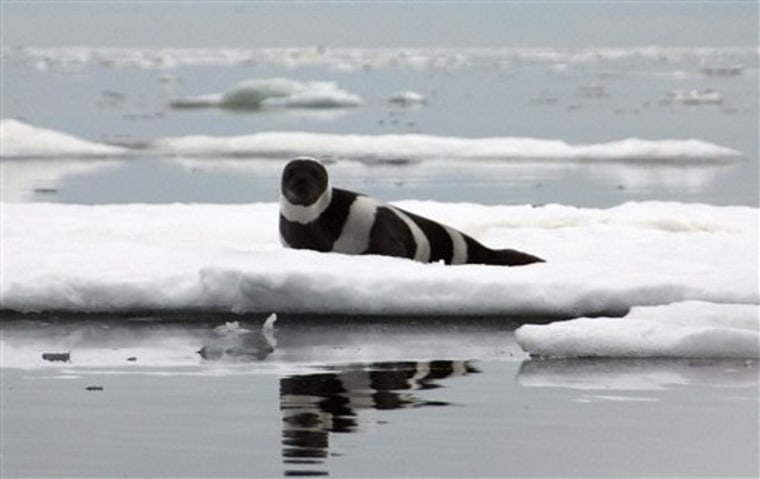A federal agency said Wednesday it will consider listing four species of ice seals as endangered, a move hailed by the environmental group that pushed for it as government recognition that Arctic marine life is threatened by global warming.
The National Marine Fisheries Service accepted a petition seeking threatened or endangered status for ribbon seals, which have been losing habitat as sea ice recedes. The agency also expanded the status review to include ringed, spotted and bearded seals.
“While the four species of ice seals in Alaska all utilize various types of sea ice habitats, they use the ice in different ways,” said Doug Mecum, acting administrator for the Alaska Region, in the announcement. “Therefore, careful status reviews of each species is warranted.”
Shaye Wolf, a biologist with the Center for Biological Diversity and the lead author of the listing petition, said the agency’s action came as a surprise, given that the U.S. Fish and Wildlife Service is two and a half months overdue on a final decision to list polar bears.
Last summer, Arctic ice shrank to an area that was 27 percent smaller than the previous record. In September, a series of reports from the U.S. Geological Survey predicted that as much as two-thirds of the polar bear population could disappear by mid-century because of the loss of summer sea ice attributed to climate change.
“The science is really clear that all of the seals are threatened by global warming by the loss of sea ice, and they all need protection,” Wolf said.
Wolf’s California-based group contends that in a warming Arctic, remaining winter sea ice will be thinner and unlikely to last long enough for ribbon seals to finish rearing their pups.
'Action may be warranted'
Federal officials have nine months to complete a full status review of ribbon seals. If agency officials propose listing ribbon seals as threatened or endangered, they would have a year to collect additional data and public testimony before the deadline for a final decision.
"Their petition states that global warming threatens ribbon seals with extinction because of the rapid melt of sea ice habitat," the National Oceanic and Atmospheric Administration said in a statement. NOAA oversees the fisheries service.
"The agency decided the petition provided enough information to indicate that action may be warranted under the law," NOAA added.
NOAA said that the agency's finding "was based, in part, on predicted changes in ribbon seals’ sea ice habitat as a result of global climate change, the high allowable seal harvest set by the Russian federation in recent years, the potential impacts of oil and gas development and production in both the United States and Russia and the potential impacts of commercial fisheries and climate change on ribbon seal prey distribution and abundance."
Listing a species would trigger a recovery plan that could address U.S. causes of global warming or other activity that could hurt the seals, such as offshore oil and gas development.
Habitat needs
Ribbon seals during summer and fall live in water and feed on fish, squid and crustaceans in the Bering and Chukchi seas. From March through June, ribbon seals rely on loose pack ice in the Bering and Okhotsk seas for reproduction and molting.
Ribbon seals birth and nurse pups exclusively on sea ice. Newborn ribbon seals have a coat of soft, white hair that provides insulation until they grow a thick layer of blubber. Pups can survive submersion in icy water only after they’ve formed the blubber layer.
Ringed seals are the smallest and most numerous of the seals that thrive off Alaska’s coasts and are the primary prey of polar bears. Ringed seals can survive in completely ice-covered waters by digging out breathing holes.
Those breathing holes eventually get covered by drifting snow and female ringed seals dig out lairs within drifts to give birth and nurse pups on sea ice. Like ribbon seals, ringed seal pups cannot survive in cold water until they’ve grown a layer of blubber.
Bearded seals are the largest of Alaska’s seals, weighing up to 750 pounds. Another prey of polar bears, they also are hunted by residents of western Alaska coastal villages for food and hides.
Spotted seals can reach weights of 270 pounds and bear young on drifting pack ice.
Groups including the Center for Biological Diversity sued Fish and Wildlife this month for missing its January deadline for a final decision on polar bears.
The conservation groups claim the Bush administration has purposely delayed a decision because a polar bear listing would focus scrutiny on outer continental shelf oil and natural gas leases in polar bear habitat off Alaska’s coast.
They also say a polar bear recovery plan required under the law would trigger agency review of new sources of greenhouse gases that contribute to warming.
